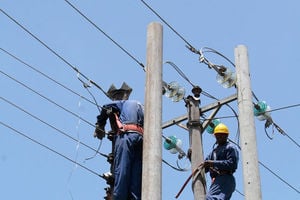
Kenya Power Company employee carries out repairs on a power transformer.
Ethiopia increased its electricity sales to Kenya by 88 per cent in the six months to June compared to a similar period last year, helping reduce infusion of locally generated thermal energy.
Kenya bought 672.26 million units of electricity from its neighbour in the period, according to data from Kenya Power.
This is nearly double the purchase of 357.44 million units from Ethiopian Electric Power (EEP) in the first half of 2023.
Ethiopia has become a major supplier of electricity to Kenya, and sells to Kenya Power at $0.065 per unit (Sh8.38 at current exchange rates), making it one of the cheapest power sources. While this is slightly more expensive than power sourced from KenGen at an average price of Sh5 per unit, it is way cheaper than purchases from independent power producers.
Crucially, the Ethiopian supply has eased use of thermal power, which is the most expensive.
Thermal generation dropped by 34 per cent to 521.02 million units in the half-year to June compared to 699.57 million units in the same period last year boosted by the cheaper imports and local generation, particularly from hydro.
The cost of this thermal generation is passed to consumers through the ordinary Power Purchase Agreement PPA) costs as well as the Fuel Energy Charge (FEC). It is the second largest component of electricity bills only behind the consumption charge and is adjusted monthly depending on the quantities of fuel used to generate power during the previous month.
Kenya imports power from both Ethiopia and Uganda. While the country has been buying power from Uganda for decades, importation from Ethiopia started in January last year.
This followed the signing of a multi-year PPA between Kenya Power and EEP in July 2022 in Nairobi.
Through the deal, Kenya imports 200 megawatts (MW) from its northern neighbour, which will be stepped up to 400MW three years from start of the importation.
The power supply is facilitated by a 2,000MW High Voltage Direct Current (HVDC) transmission line connecting the two countries.
This also comes at a time when electricity demand in Kenya is growing, necessitating an increase in both local generation and imports.
Higher demand is supported by rapid connections of new customers to the national power grid by Kenya Power.
This saw peak power demand hit a new record of 2,228.11MW at the end of July.







